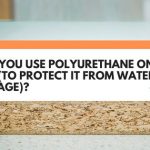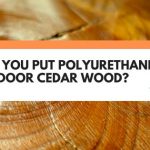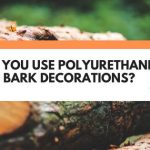Polyurethane is a fantastic waterproofing wood finish. It can be applied over most other wood finishes and stains.
And, unlike some popular oil finishes, it doesn’t need frequent reapplications. What’s more, it is one of just a few truly waterproofing wood sealants.
Now, with a wood such as Maple, this is really good news. Why? Well, because natural Maple wood will need a water-resistant sealant to safeguard it.
But, is polyurethane the right sealer for Maple?
Well, in this post, you’ll discover why Maple — despite it’s toughness — often needs a wood finish to protect it from decay. You’ll also learn why polyurethane is so much more water-resistant than oil finishes, such as Linseed oil and Tung oil.
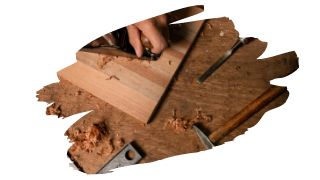
This post may contain affiliate links to products that we receive a commission for (at no additional cost to you). Learn more here.
Is Maple Naturally Water-Resistant?
No, far from it. This hardwood doesn’t have any natural characteristic to protect it from wood rot and decay.
It doesn’t have wood preserving tree oils, like Teak wood does. Nor does it have the warp-resistance of a Douglas Fir either.
Related Post: What’s The Difference Between Douglas Fir Vs Whitewood?
So Can Maple Really Warp Easily?
Yes it does. In-spite of the tough hardness of this timber, that’s not enough to prevent it from twisting and cracking due to moisture and humidity.
The only type of Maple wood that doesn’t crack in this way will have been specially treated.
Roasted Maple comes from natural Maple wood. However, Roasted Maple has been put through a super-heated caramelizing treatment. And that treatment makes Roasted Maple much more stable than Maple otherwise would be.
Related Post: Is Maple Wood A Good Choice For Outdoor Furniture?
And What Causes Maple Wood To Warp?
Heat and moisture are the two key reasons for warping. As wood absorbs water, it expands and swells. As it dries out due to heat, it shrinks and contracts.
Now, dimensionally stable woods, (such as Douglas Fir), don’t move and shift like this (or at least not as much). But the less stable a wood is, the more likely it is to warp — and form wood checks — due to changes in humidity.
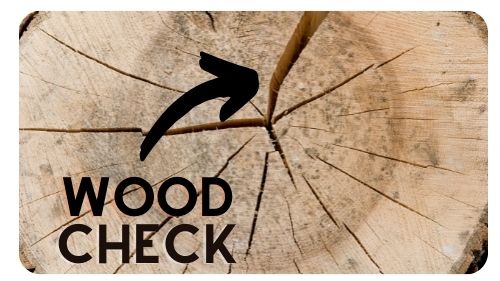
Does That Mean Maple Wood Needs To Be Sealed?
If you want that Maple wood to last a good long while, then yes it does.
And applying a water-repelling wood penetrating finish is the best way to block moisture absorption.
So What’s The Best Type Of Finish For Raw Maple Wood?
An oil finish, such as Tung oil or Boiled Linseed oil, are great for giving Maple the most natural finishing coat.
Tung oil is a clear finish that will really enhance the look of Maple’s wood grain. However, it is a very slow dryer, easily taking over a month to fully cure.
Related Post: Tung Oil Not Drying? (3 Simple Ways To Fix It)
While, Boiled Linseed oil (BLO) is a derivative of Raw Linseed oil. With its fast-drying chemical additives, BLO dries in a fraction of the time of either Linseed oil or Tung oil.
It gives the surface of wood a deep honey color too, one that looks outstanding once cured.
However, it is worth noting that Boiled Linseed oil finishes can darken wood over time. Still, that doesn’t take away from the fact that BLO can add beautiful color to raw Maple’s otherwise pale grain.
What About Polyurethane? Is It Also Good For Maple?
Polyurethane works great on Maple wood. And a clear oil-based polyurethane finish won’t hide away the natural texture of this timber either.
Polyurethane is especially good if you’re looking for a truly water-resistant finish to safeguard timber surfaces. That’s because polyurethane is just one of a handful of wood finishes that offers true water-resistance.
Oils, Lacquers, and Shellac, can all become damaged if enough water gets spilled on them. This is because these wood finishes leave behind a microporous coat. And a microporous coat is one that’ll allow water vapor (i.e. humidity) through — but will block water droplets all the same.
What’s So Special About Polyurethane Wood Finishes?
Well, polyurethane is made up of tightly bonded resin molecules that’ll wrap wood in a waterproof seal. Although, the urethane ingredient in polyurethane, can leave the surface of wood looking like its been covered in Saran wrap.
Still, polyurethanes plastic-like flexibility, offers enough give to make this finish more scratch resistant than drying oils.
And Should You Seal Maple Wood With Polyurethane Before Staining It?
Well, wood stains add color by soaking right down into wood pores. However, wood sealers work to prevent liquid droplets — whether it be water or stain — from getting past.
So, you should always apply wood stain first. And then top coat with a wood sealer, (like polyurethane), afterwards.
To Wrap Up, Here Are The 3 Key Takeaways From This Post…
- 1). Maple wood is a tough wood, but it is not rot-resistant or warp-resistant. So, it will need a wood finish to protect it from moisture and water damage.
- 2). Polyurethane is a fantastic wood sealer, as it can form a water-resistant seal around Maple.
- 3). Polyurethane sealers should always be applied as a final top coat. Any penetrating wood stains or dyes should be coated on, (and given time to dry), before you seal Maple wood.
References:
Yang, Han-Seung, et al. “Water absorption behavior and mechanical properties of lignocellulosic filler–polyolefin bio-composites.” Composite structures 72.4 (2006): 429-437.

